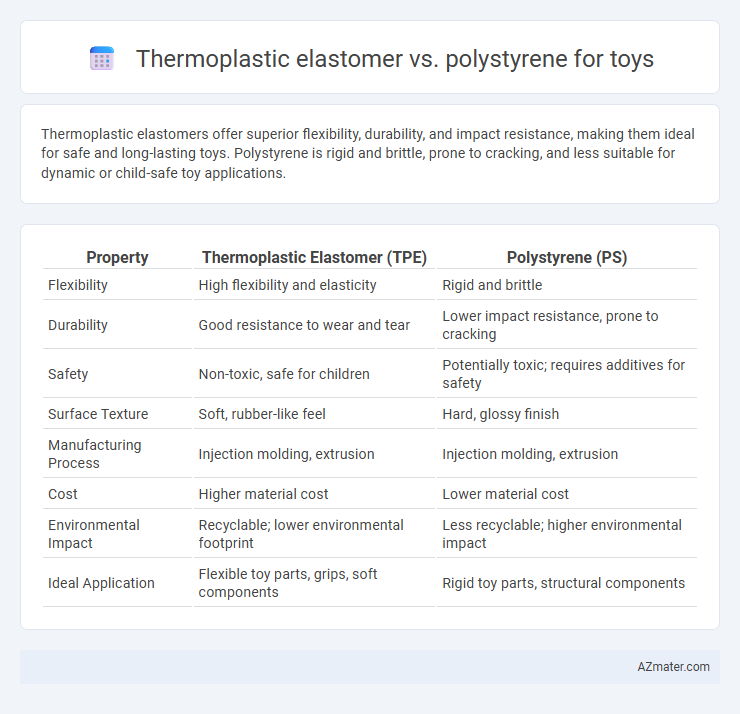Thermoplastic elastomers offer superior flexibility, durability, and impact resistance, making them ideal for safe and long-lasting toys. Polystyrene is rigid and brittle, prone to cracking, and less suitable for dynamic or child-safe toy applications.
Table of Comparison
| Property | Thermoplastic Elastomer (TPE) | Polystyrene (PS) |
|---|---|---|
| Flexibility | High flexibility and elasticity | Rigid and brittle |
| Durability | Good resistance to wear and tear | Lower impact resistance, prone to cracking |
| Safety | Non-toxic, safe for children | Potentially toxic; requires additives for safety |
| Surface Texture | Soft, rubber-like feel | Hard, glossy finish |
| Manufacturing Process | Injection molding, extrusion | Injection molding, extrusion |
| Cost | Higher material cost | Lower material cost |
| Environmental Impact | Recyclable; lower environmental footprint | Less recyclable; higher environmental impact |
| Ideal Application | Flexible toy parts, grips, soft components | Rigid toy parts, structural components |
Introduction to Toy Material Selection
Thermoplastic elastomers (TPE) offer superior flexibility, impact resistance, and safety compliance compared to polystyrene (PS) in toy manufacturing, making them ideal for products requiring durability and child-friendly textures. Polystyrene, known for its rigidity and ease of molding, is commonly used in cost-sensitive, structurally simple toys but lacks the resilience and tactile safety of TPE. Selecting toy materials involves balancing mechanical properties, safety standards, and end-user experience, with TPE often favored for interactive and high-impact applications while PS remains a choice for lightweight and decorative components.
What Are Thermoplastic Elastomers?
Thermoplastic elastomers (TPEs) are versatile materials combining the elasticity of rubber with the recyclability of plastics, making them ideal for toy manufacturing due to their softness, durability, and safety. Unlike polystyrene, which is rigid and brittle, TPEs provide enhanced impact resistance and flexibility, reducing the risk of breakage and injury in children's toys. Their ability to be molded repeatedly without loss of properties supports sustainable production practices and customization in toy design.
Understanding Polystyrene in Toy Manufacturing
Polystyrene is a widely used thermoplastic polymer in toy manufacturing due to its clarity, rigidity, and ease of molding, making it ideal for creating detailed and colorful toy components. Unlike thermoplastic elastomers, which offer flexibility and impact resistance, polystyrene provides superior dimensional stability and gloss, enhancing the aesthetic appeal of toys. Its cost-effectiveness and recyclability also contribute to its popularity in producing a vast range of toys, from action figures to model kits.
Key Physical Properties: TPE vs Polystyrene
Thermoplastic elastomers (TPE) exhibit superior flexibility and impact resistance compared to polystyrene, making them ideal for toys requiring durability and safe handling. TPE offers excellent elasticity and tear resistance, while polystyrene is rigid, brittle, and prone to cracking under stress. The low density and high resilience of TPE contribute to lightweight, soft-touch toys, contrasting with the harder, more fragile nature of polystyrene-based toys.
Safety and Toxicity Considerations for Toys
Thermoplastic elastomers (TPE) are preferred for toy manufacturing due to their non-toxic, hypoallergenic properties and ability to meet stringent safety standards such as EN71 and ASTM F963. In contrast, polystyrene (PS) toys may pose higher risks of brittleness and release of styrene monomers, which can be harmful if ingested or inhaled, especially for children. Regulatory agencies emphasize using materials like TPE to minimize chemical exposure and physical hazards in toys, ensuring safer play environments.
Durability: Which Material Lasts Longer?
Thermoplastic elastomers (TPE) exhibit superior durability in toys due to their enhanced flexibility and resistance to wear, making them less prone to cracking or breaking under stress compared to polystyrene (PS). Polystyrene, although rigid and cost-effective, tends to become brittle over time, especially when exposed to impact or environmental stressors, reducing its lifespan in toy applications. The longevity of TPE in toys is further supported by its ability to withstand repetitive deformation, offering extended usability and safety during rough play.
Flexibility and Design Versatility
Thermoplastic elastomers (TPE) offer superior flexibility compared to polystyrene, making them ideal for toys requiring soft, bendable, and impact-resistant properties. TPE's design versatility allows for intricate molds, vibrant colors, and varied textures, enhancing tactile and aesthetic appeal. Polystyrene, while rigid and easier to mold with fine detail, lacks the elasticity needed for durable, child-safe flexible toys.
Cost-Effectiveness in Production
Thermoplastic elastomers (TPE) offer superior cost-effectiveness in toy production due to their recyclability and reduced molding cycle times, lowering overall manufacturing expenses. Polystyrene (PS), while cheaper per unit material cost, often involves higher waste and longer cooling times, which can increase production costs over large runs. The flexibility and durability of TPE reduce post-production defects and assembly needs, leading to enhanced cost savings compared to rigid polystyrene counterparts.
Environmental Impact and Recyclability
Thermoplastic elastomers (TPE) offer superior environmental benefits compared to polystyrene (PS), as TPEs are fully recyclable and can be reprocessed multiple times without significant loss of properties, reducing landfill waste. Polystyrene, especially in its expanded form (EPS), poses significant environmental challenges due to its non-biodegradability and limited recycling infrastructure, often leading to persistent pollution and microplastic contamination. The energy consumption in producing TPE is generally lower, and its chemical composition enables easier material recovery, making TPE a more sustainable choice for toy manufacturing focused on environmental impact and recyclability.
Which Material Is Best for Toys? Final Comparison
Thermoplastic elastomers (TPE) offer superior flexibility, durability, and impact resistance compared to polystyrene, making them ideal for toys that require softness and safety for children. Polystyrene, known for its rigidity and ease of molding, is better suited for rigid, lightweight toys but lacks the shock absorption and resilience TPE provides. Evaluating factors like safety standards, tactile comfort, and long-term durability, thermoplastic elastomers generally outperform polystyrene in producing safer and more durable toys.

Infographic: Thermoplastic elastomer vs Polystyrene for Toy
 azmater.com
azmater.com